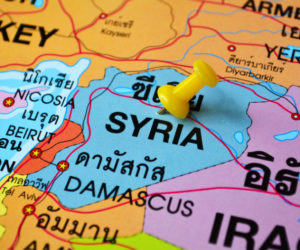Update:
According to DoD, B-52s that arrived at Udeid Air Base, Qatar, on April 9, have seen their first combat against ISIL.
The U.S. Air Force’s B-52 Stratofortress bomber conducted its first mission against ISIL Monday. It targeted an ISIL weapons storage facility in Qayyarah, Iraq.
When DoD spokesman Col. Warren was asked about concerns that the use of B-52s could cause civilian casualties, Warren answered:
So, the B-52s really are replacing the B-1s that have been flying here for almost a year. They have larger capability and in some cases a little bit more. They can carry a heavy payload.
They conduct the same level of precision which is why I really wanted to show you the video. I know there are memories — you know, — in the collective unconscious of B-52s decades ago doing very sort of less discriminate, arguably indiscriminate bombings. I guess that’s where the phrase “carpet bombing” originally came from back in the “Linebacker” days.
Those days are long gone. The B-52 is a precision strike weapon system, weapons platform. It will conduct the same type of precision strikes that we’ve seen for the last 20 months here in this theater. So it is simply a replacement for the B-1.
Obviously, the B-52 does have a long and very illustrious history. So we do like to talk about it. But really, it’s — it’s simply another platform from which we can launch our precision strikes.
Original post:
The daily Combined Joint Task Force Operation Inherent Resolve (OIR) report on coalition strikes against ISIL terrorists in Iraq and Syria typically reads: U.S. and coalition “fighter, ground attack and remotely piloted aircraft and rocket artillery conducted (number) strikes in Iraq” and provides similar information on attack aircraft strikes conducted in Syria along with specific strike assessments.
Coalition nations conducting strikes in Iraq include, in addition to the U.S., Australia, Belgium, Canada, Denmark, France, Jordan, the Netherlands and the United Kingdom. Those conducting air strikes in Syria include Australia, Bahrain, Canada, France, Jordan, the Netherlands, Saudi Arabia, Turkey, the United Arab Emirates, the United Kingdom and the U.S.
There are a total of 19 coalition nations participating in Operation Inherent Resolve.
As part of putting increased pressure on ISIL, expect to see the venerable, mighty B-52 Stratofortress added to this list in the near future as B-52s from Barksdale Air Force Base, Louisiana, have arrived at Al Udeid Air Base, Qatar, April 9, to join the coalition efforts to eliminate ISIL.
“The B-52 will provide the coalition continued precision and deliver desired airpower effects,” said Lt. Gen. Charles Q. Brown Jr., the commander of U.S. Air Forces Central Command and Combined Forces Air Component. “As a multi-role platform, the B-52 offers diverse capabilities including delivery of precision weapons and the flexibility and endurance needed to support the combatant commanders’ priorities and strengthen the coalition team.”
More from Air Forces Central Command:
Crews will be available to carry out missions in both Iraq and Syria as needed to support air tasking order requirements.
“The B-52 demonstrates our continued resolve to apply persistent pressure on (ISIL) and defend the region in any future contingency,” Brown said.
This deployment is the first basing of the B-52s in the U.S. Central Command area of responsibility in 26 years. The B-52s were based in Saudi Arabia supporting Operation Desert Storm. The B-52s were last flown operationally during Operation Enduring Freedom in May 2006, and during Exercise Eager Lion, a USCENTCOM-led multilateral exercise in Jordan, in May 2015.
According to the Command, the coalition conducted more than 33,000 airpower missions in support of OIR. Since the beginning of the operation, the coalition struck about 459 vehicle-borne improvised explosive devices, 776 mortar systems, 1,933 logistics buildings housing these weapons, 662 weapons caches, and 1,341 staging areas.
As of February 29, 2016, the total cost of operations related to ISIL since kinetic operations started on August 8, 2014, is $6.5 billion and the average daily cost is $11.4 million for 571 days of operations. A further breakdown of cost associated with the operations is here.
Watch the arrival of the B-52s here.

U.S. Air Force B-52 Stratofortress aircraft from Barksdale Air Force Base, Louisiana, arrives at Al Udeid Air Base, Qatar, April 9, 2016 in support of Operation Inherent Resolve. The B-52 offers diverse capabilities including the delivery of precision weapons. (U.S. Air Force photo by Tech. Sgt. Nathan Lipscomb)
From a previous article on the B-52:
The B-52 has been around since 1954 when the “A” model came into service — that is more than 60 years ago — an amazing feat for a combat aircraft. Even more amazing, current engineering analyses show the B-52’s life span to extend beyond the year 2040.
A total of 744 B-52s were built with the last, a B-52H, delivered in October 1962. The first of 102 B-52H’s was delivered to Strategic Air Command in May 1961. The H model can carry up to 20 air-launched cruise missiles.
The long-range, heavy bomber can perform a variety of missions flying at high subsonic speeds at altitudes up to 50,000 feet. With the use of aerial refueling, the B-52’s range is limited only by crew endurance. It has an unrefueled combat range in excess of 8,800 miles.
The backbone of our manned strategic bomber force, the B-52 can carry nuclear or precision guided conventional ordnance with worldwide precision navigation capability.
In a conventional conflict, the B-52 can perform strategic attack, close-air support, air interdiction, offensive counter-air and maritime operations.
During Desert Storm, B-52s delivered 40 percent of all the weapons dropped by coalition forces. It is also highly effective for ocean surveillance and can assist the U.S. Navy in anti-ship and mine-laying operations. Two B-52s, in two hours, can monitor 140,000 square miles of ocean surface.
A potent deterrent during the Cold War, the B-52 has seen action in Operation Desert Storm, Operation Allied Force, Operation Desert Strike, Operation Iraqi Freedom, Operation Enduring Freedom and participated in other missions and Operations.
Only the H model is still in the Air Force inventory and is assigned to the 5th Bomb Wing at Minot AFB, North, Dakota, and the 2nd Bomb Wing at Barksdale AFB, which fall under Air Force Global Strike Command. The aircraft is also assigned to the Air Force Reserve Command’s 307th Bomb Wing at Barksdale AFB.
Airmen assigned to the 20th Expeditionary Bomb Squadron at Barksdale Air Force Base, La., inspect the bomb bay of a B-52 Stratofortress after arriving at Al Udeid Air Base, Qatar, April 9, 2016, to support Operation Inherent Resolve. (U.S. Air Force photo/Tech. Sgt. Nathan Lipscomb)
Lead photo: B-52 Stratofortress from Barksdale Air Force Base, Louisiana, touches down at Al Udeid Air Base, Qatar, April 9, 2016. (U.S. Air Force photo by Tech. Sgt. Nathan Lipscomb)


















